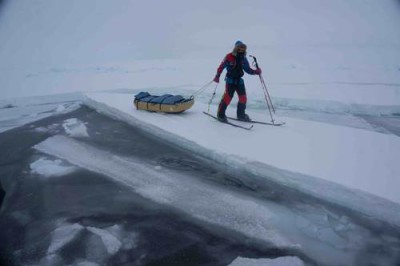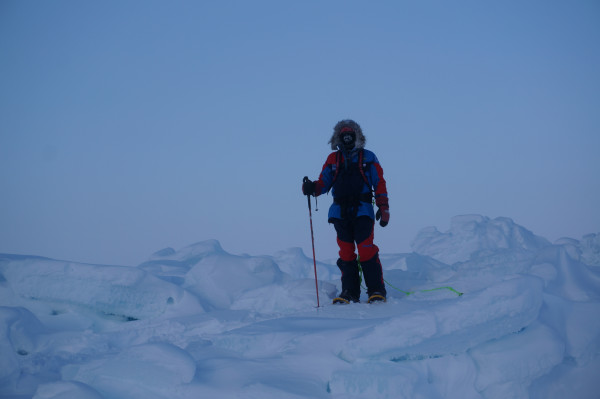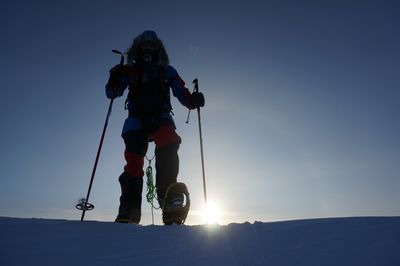INTERVIEW: Eric Larsen heads to North Pole on climate-change special

Few people can boast of being a polar explorer, but that description perfectly fits Eric Larsen and his life of adventure. The intrepid traveler has accomplished some impressive feats over the course of his life. Six years ago, for example, he reached the North Pole, South Pole and summit of Mount Everest within 365 days.
Most recently, he headed back to the North Polar with exploring partner Ryan Waters. Their trip was physically challenging but also symbolically important: The two were trying to tell the world about the realities of climate change and the ever-changing landscape of the Arctic.
Their adventures are the subject of Animal Planet’s new two-hour documentary, Melting: Last Race to the Pole, which premieres Wednesday, Dec. 9 at 9 p.m.
“I would say there’s not a ton of fans of polar exploration just in general,” Larsen said recently during a phone interview. “I’m kind of involved in a sport that’s on the periphery of the adventure world, and I actually see that as a huge opportunity. But in terms of just overall what this story is like, I call it the story of the most difficult expedition on the planet to a place that few people really understand that may be the last of its kind in history.”

Melting is a self-shot documentary, so Larsen and his partner needed to not only survive. They also needed worry about filming that survival. They capture events in real time with real emotions. Larsen called it an “honest and sincere” look at what the explorers went through, a “difficult journey” only completed by a handful of people.
“The teamwork aspect is fundamental to our ability to move forward and equally important simply just to survive,” he said. “Our lives are literally in each other’s hands at any given moment, so we rely very heavily on one another. … I mean that trip is so hard that to do that individually is impossible, and so we definitely were able to work together as a team. And that was a fundamental part of us being out there. There’s obviously like highs and low moments in that, and there are some frictions anytime you’re with somebody for that long of a time in such an intense situation.”

Larsen’s wife apparently asked him before this third trek to the North Pole whether he was “crazy.” “Why are you going back,” he remembers her saying. His reasoning this time was to show people that the environment up north is changing — drastically.
“I have this unique perspective to comment on what that area is like,” he said. “And the ice is different than it has been when I was there last 2010, or when I was there in 2006. … And the character and the nature of ice is different. The weather is more variable. The kind of the way that the ice moves is much more different in the sense that there’s less total area of ice, so less landlocked ice around the perimeter, which means it moves more arbitrarily due to the wind.”
Larsen called the Arctic Ocean a “dynamic place” that’s different from Antarctica and the South Pole. He described the southern spot as snowy and icy but all “piled up.” There are times when the ice at the South Pole is thousands of feet deep. The North Pole, on the other hand, is much more extreme with thinner ice pockets. When Larsen was in the Arctic Ocean, he could see the ice moving.
“And, for example, we would set up our tent at night, and there’s an overall drift to the ice,” he said. “And we would drift upward of 2 miles south at times, so it was like we were almost traveling on this conveyor belt pushing us backwards as well.”
Polar bears weren’t everywhere, but there were some sightings and tracks found. Larsen didn’t think the marine mammals would be paying them a visit, but he was disconcertingly surprised.
“On the first day, we saw some tracks, and I thought, OK, we got that over with,” he said. “Those polar bears are walking that way. We’ll never see them again, but we did have a very close encounter with a couple of polar bears that were stalking us and came very close to us. And we also encountered some more tracks very close to the North Pole near the end of the expedition, tracks of a very large male, which, you know, a polar bear way up there is going to be a very hungry polar bear. And a polar bear looking at two stinky guys that haven’t had a shower in two months, that’s like two all-beef patties, and our tent is like a Big Mac wrapper.”
Growing up, Larsen, who always enjoyed being outside and camping, would read of the adventures of the famous polar explorers, several of them from Norway. When he read those expedition journals, he didn’t think, “Oh my God, I would never want to do that.” The reaction was quite the opposite: “I would think I really want to do that, and then even later on, you know, as I was doing more expeditions, I still read those books as a means of what happened here, what were the conditions like, what did they do well as a team, what did they do that kind of messed up that team dynamic or what equipment were they using. And while it may have changed slightly, there are some important kind of points to be taken out of those. So I’m a huge fan of that kind of expedition literature genre, the journals and the first-hand accounts of all those old explorers.”
Still, heading for the poles of the earth can’t sit well with all family members and friends, but Larsen said, somewhat surprisingly, that his family is “very supportive.”
“That does make it easier,” he said. “When I was on the North Pole I had a son, and now I have two kids. And so there’s a struggle that goes inside of me, which is dealing with two of those lives. One is the really intense expedition situations that are oftentimes life-threatening and very mentally challenging, and then the other is trying to be a good husband and father. And so unfortunately those are in direct conflict, and so it’s a constant struggle for me, that going back and forth. In terms of just overall support, there are always people constantly that say you can’t do things. And for me I almost welcome those conversations because it is an opportunity to hopefully prove them wrong.”
Larsen said most people have a rudimentary understanding of the Arctic Ocean, so he hopes Melting will help people connect with that faraway place.
“I think it’s a compelling story line to be able to talk about a place, and equally important to me, if not more important, is this idea of a place that is forever changing,” he said. “You know, the question I get is, is it true what the scientists say is happening out there? And I could say, yes, it is in a compelling way, in an entertaining way and hopefully in an inspirational way, and remind people that we all have the ability to make big changes. I mean Ryan and I did this trip. It was hard. We were never certain that we were going to make it, and I think those lessons really apply to some of these bigger issues, especially environmental issues like climate change.”
By John Soltes / Publisher / John@HollywoodSoapbox.com
- Melting: Last Race to the Pole airs Wednesday, Dec. 9 at 9 p.m on Animal Planet. Click here for more information.

